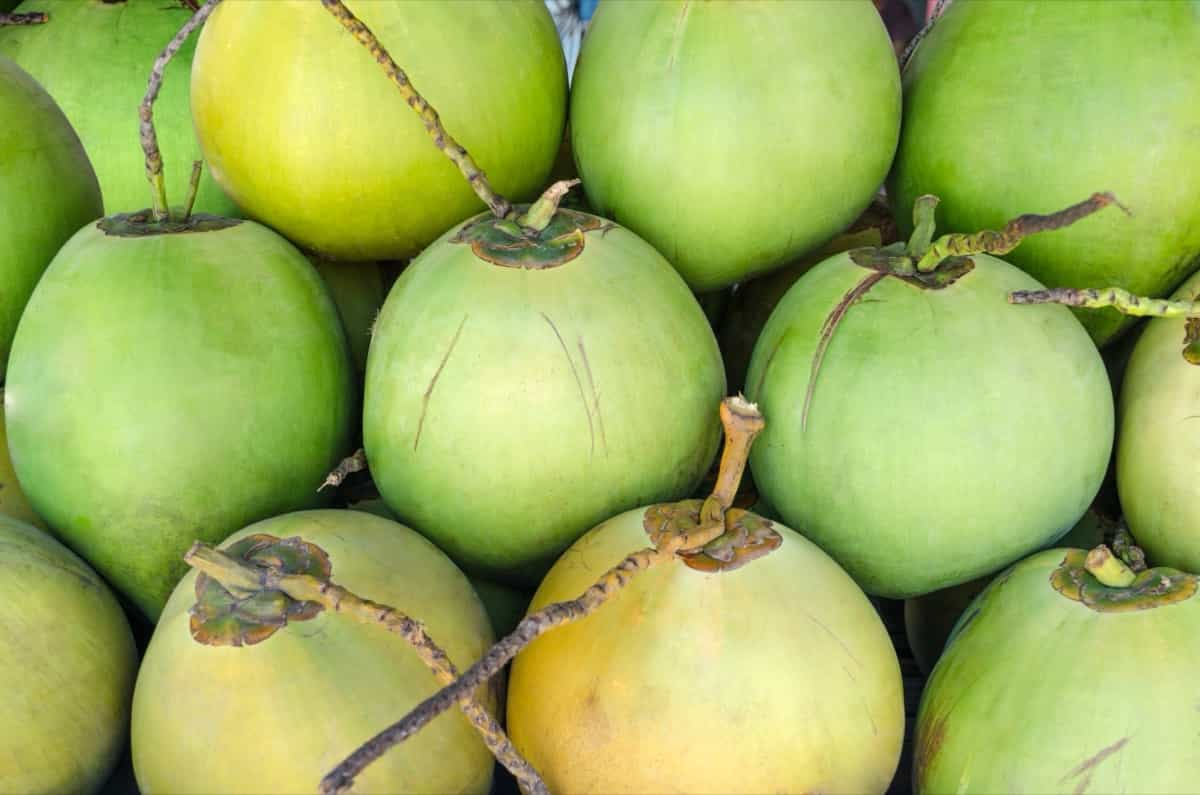The Coconut tree, scientifically known as Cocos nucifera, holds a unique distinction as the sole living species in the genus Cocos. Non-fruiting Coconut trees can be frustrating for any Coconut enthusiast. Understanding the reasons behind non-fruiting Coconut trees is crucial to address the issue effectively.

Several factors can be important to the lack of fruit production in Coconut trees. Environmental conditions such as inadequate sunlight, improper irrigation, or nutrient deficiencies are common culprits. Pests and diseases can also hinder fruitful outcomes in Coconut trees.
Understanding Coconut Tree Fruitlessness
Causes of Non-Fruiting Coconut Trees
Understanding the causes behind non-fruiting Coconut trees is crucial for ensuring optimal production. Inadequate irrigation practices can also contribute to non-fruiting Coconut trees. Overwatering or underwatering can hinder the tree’s reproductive capabilities and lead to poor fruit development.
Nutritional management is key in addressing fruitlessness in Coconut trees. Ensuring that the tree receives essential nutrients through a balanced fertilization regime is vital for promoting fruit development. Lack of nutrition can result in stunted tree growth and low yields.
Impact of Environmental Factors on Coconut Production
Environmental factors play a significant role in Coconut tree fruitlessness. Factors like temperature, humidity, and soil quality can impact the tree’s ability to produce Coconuts. By understanding these factors and taking proactive measures, you can help your Coconut trees thrive and yield abundant fruits.
Optimal Irrigation for Coconut Trees
Watering Requirements for Fruit Bearing
Proper irrigation is crucial for Coconut trees to bear fruit. These tropical beauties thrive in well-drained soil with consistent moisture levels. When it comes to watering Coconut trees, finding the right balance is key. Adjust the watering schedule according to weather conditions and seasonality to ensure optimal hydration without drowning or dehydrating your Coconut trees. Remember, happy roots equal fruitful harvests.
Signs of Over and Underwatering in Coconut Trees
Overwatering can lead to root rot and hinder fruit production. Signs of overwatering include yellowing leaves, wilting, and a musty smell emanating from the soil. On the other hand, underwatering can cause stunted growth and reduce flower and fruit formation. To meet their watering requirements, Coconut trees typically need about 1-1.5 inches of water per week during dry periods. It’s essential to observe the soil moisture level regularly by checking the top few inches for dryness.
Nutritional Management for Coconut Health
Essential Nutrients for Coconut Fruit Development
Nutritional management plays a vital role in the health and fruit development of Coconut trees. Regular soil testing can help determine nutrient deficiencies and guide fertilizer application. By understanding your Coconut tree’s nutritional needs and implementing a tailored fertilization plan, you can support healthy fruit development and maximize yields over time.
Implementing a Balanced Fertilization Regime
Implementing a balanced fertilization regime is key to providing the necessary elements for robust fruit production. Nitrogen aids in leafy green growth, phosphorus supports root development, potassium enhances flowering and fruiting, while magnesium and calcium contribute to overall tree health. It’s essential to ensure that these nutrients are provided in the right amounts at the correct times during the tree’s growth stages.
In case you missed it: Dwarf Coconut Farming: Best Varieties, Planting, Propagation, and Care

Soil Health and Fertility
Enhancing Soil Structure for Coconut Trees
By enhancing the soil structure, you can improve water retention and root development, ultimately leading to better fruit production. Incorporating organic matter like compost or mulch can help boost nutrient levels in the soil, providing essential elements for healthy Coconut tree growth.
Correcting Soil pH for Optimal Nutrient Uptake
Correcting soil pH is another key factor in promoting optimal nutrient uptake by Coconut trees. A pH level that is too high or too low can hinder the tree’s ability to absorb necessary nutrients from the soil. Conducting a soil test and adjusting the pH accordingly through amendments such as lime or sulfur can create a more favorable environment for Coconut trees to thrive. Maintaining a balanced soil structure and pH level sets the foundation for healthy Coconut tree growth and fruitful yields.
Pest and Disease Management
Common Pests and Diseases Affecting Coconut Fruitfulness
Pests and diseases can be a major hindrance to Coconut fruitfulness, affecting the overall health of the trees. Common pests like Coconut mites, rhinoceros beetles, and red palm weevils can cause significant damage if left unchecked. These pests feed on plant tissues, disrupt nutrient uptake, and weaken the tree’s ability to produce fruits. On the other hand, diseases such as stem bleeding, root wilt, and lethal yellowing can also impact Coconut productivity. It is crucial to promptly identify these issues to prevent further spread within the plantation.
Organic and Chemical Treatment Options
Organic treatment options like neem oil or garlic spray can help control pests without harming beneficial insects or pollinators. Chemical treatments can also be important in severe cases but should be used judiciously following recommended safety guidelines. Regular monitoring for early detection coupled with proper cultural practices is key to maintaining healthy Coconut trees resilient against pest infestations and diseases.
Proper Cultural Practices
Pruning and Spacing for Maximum Yield
Proper cultural practices play a major role in maximizing the yield of Coconut trees. Pruning involves removing dead or diseased fronds to promote new growth and enhance sunlight penetration. This practice also helps maintain tree health and vigor, ultimately leading to increased fruit production. Spacing between Coconut trees is essential for optimal growth and development.
The Role of Mulching in Fruit Production
Mulching is another key practice that contributes to fruit production in Coconut trees. By covering the soil around the base of the tree with organic matter like leaves or compost, mulching helps retain moisture, suppresses weeds, regulates soil temperature, and provides essential nutrients as it decomposes. Incorporating proper pruning techniques along with appropriate spacing and effective mulching can significantly improve Coconut tree productivity over time.
Importance of Pollination
Enhancing Pollinator Activity Around Coconut Trees
Pollination plays a crucial role in the fruitfulness of Coconut trees. Without proper pollination, the development of Coconuts can be hindered. To enhance pollinator activity around Coconut trees, creating a welcoming environment for bees and pollinators is essential. Planting flowering plants nearby can attract these beneficial insects.
Addressing Pollination Issues to Improve Yield
Addressing any pollination issues that may arise is key to improving yield. If there is a lack of natural pollinators in the area, manual hand pollination can be considered an effective solution. This process involves transferring pollen from male to female flowers by hand, ensuring successful fertilization. Ensuring a healthy population of pollinators through sustainable farming practices not only benefits Coconut production but also supports overall biodiversity.
In case you missed it: How to Install Drip Irrigation in Coconut Plantation: Layout, Design, and Cost Per Acre

Climate and Environmental Adaptation
Adapting Coconut Cultivation to Climate Changes
Adapting Coconut cultivation to climate changes is crucial for the sustainable growth of Coconut trees. With shifting weather patterns and environmental challenges, it’s essential to implement strategies that ensure the health and productivity of Coconut orchards.
Managing Environmental Stressors for Healthy Growth
Managing environmental stressors such as extreme temperatures, droughts, or heavy rainfall requires proactive measures. By utilizing techniques like mulching, proper irrigation systems, and windbreaks, farmers can help shield Coconut trees from adverse conditions. Choosing resilient Coconut varieties that are better suited to changing climates can also make a significant difference in ensuring successful fruit production.
Genetic Selection for Improved Varieties
Choosing High-Yielding Coconut Varieties
When it comes to maximizing Coconut fruit production, choosing high-yielding varieties is crucial. Genetic selection plays a significant role in determining the productivity of Coconut trees. By selecting improved varieties known for their high yield potential, farmers can ensure a more abundant harvest.
The Role of Grafting in Enhancing Fruit Production
Grafting is another technique that can enhance fruit production in Coconut trees. It involves combining the desirable traits of one tree with the root system of another to create a stronger and more productive plant. Grafted Coconut trees often exhibit increased resistance to diseases and environmental stressors, leading to better fruit development.
Regular Monitoring and Maintenance
Schedule for Inspection and Care of Coconut Trees
Regular monitoring and maintenance of Coconut trees are crucial for ensuring optimal fruit production. A consistent schedule for inspection and care is necessary to identify any issues early on and address them promptly. By conducting regular checks on the health of the trees, you can prevent potential problems from escalating.
Long-term Strategies for Sustaining Fruit Production
Long-term strategies play a key role in sustaining fruit production over time. Implementing practices that promote tree growth and vitality, such as proper pruning techniques and nutrient management, can contribute to a healthy harvest season after season. It’s essential to establish a comprehensive plan that takes to the specific requirements of your Coconut trees.
In case you missed it: How to Make Coconut Shell Charcoal for Plants: DIY at Home

Conclusion
Understanding why Coconut trees fail to produce fruit can be a frustrating challenge for many growers. Many factors can contribute to this issue, ranging from environmental conditions to nutritional deficiencies. Addressing these underlying causes is key to promoting healthy Coconut tree growth and enhancing fruit production potential. To promote fruit development, ensure that your Coconut tree receives optimal care.
- Feed Your Flock for Less: Top 10 Tips to Save on Chicken Feed
- Ultimate Guide to Ossabaw Island Hog: Breeding, Raising, Diet, and Care
- Hatching Answers: The Top 10 Reasons Your Chickens Aren’t Laying Eggs
- Eggs and Economics: Breaking Down the Cost of Raising Backyard Chickens
- Defend Your Greens: Proven Methods to Keep Iguanas Out of Your Garden
- Ultimate Guide to Cinnamon Queen Chicken: A Comprehensive Guide for Beginners
- Ultimate Guide to California Tan Chicken: Breeding, Raising, Diet, Egg-Production and Care
- Ultimate Guide to Marsh Daisy Chicken: Breeding, Raising, Diet, and Care
- 10 Types of Chicken Farming Businesses You Can Start for Profits